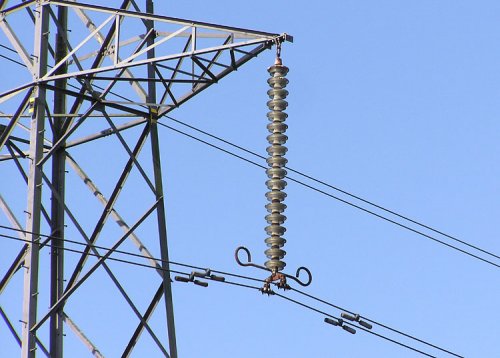Vibration and dancing of wires on overhead power lines
On the job study air lines Under natural conditions, in addition to the usual changes caused in the operation of conductors by the action of ice, wind and temperature, the phenomena of vibrations and dances of conductors are of interest.
The vibration of the wires in the vertical plane is observed at low wind speeds and consists in the appearance in the wires of longitudinal (standing) and mainly wandering waves with an amplitude of up to 50 mm and a frequency of 5-50 Hz. The result of the vibrations are the breaks of the conductors of the wires, the self-loosening of the bolts of the supports, the destruction of the parts of the fittings of the insulating strings, etc.
To combat vibrations, the wires are reinforced by coiling in the attachment points, auto-vibration clamps and silencers (shock absorbers).
In overhead lines, there is, although less often, another, less studied phenomenon — the dance of the conductors, that is, the oscillation of the conductors with a large amplitude, which leads to the collision of the conductors of different phases, and therefore, the drop line does not work.
Wire vibration
When the air flow around the conductors is directed through the axis of the line or at an angle to this axis, vortices arise on the leeward side of the conductor. The wind is periodically separated from the wire and vortices are formed in the opposite direction.
The separation of the vortex at the bottom causes the appearance of a circular flow on the leeward side, and the flow velocity v at point A becomes greater than at point B. As a result, a vertical component of wind pressure appears.
When the frequency of vortex formation coincides with one of the natural frequencies of the stretched wire, the latter begins to vibrate in the vertical plane. In this case, some points mostly deviate from the equilibrium position, forming the antinode of the wave, while others remain in place, forming the so-called nodes. Only angular displacements of the conductor occur at the nodes.
Such are called vibrations of a wire with an amplitude not exceeding 0.005 half-wave length or two diameters of the wire vibration.
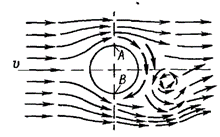
Figure 1. Vortex formation behind the wire
Wire vibrations occur at a wind speed of 0.6-0.8 m / s; as the wind speed increases, the vibration frequency and the number of waves in the range increase; when the wind speed exceeds 5-8 m / s, the vibration amplitudes are so small that they are not dangerous for the conductor.
Operational experience shows that wire vibrations are most often observed on lines passing through open and flat terrain. On sections of lines in the forest and uneven terrain, the duration and intensity of vibrations are much less.
Wire vibration is observed, as a rule, at distances longer than 120 m and increases with increasing distances.Vibrations are especially dangerous when crossing rivers and water areas with distances of more than 500 m.
The risk of vibration lies in the breakage of individual wires in the areas where they exit the clamps. These discontinuities are due to the fact that alternating stresses from periodic bending of the wires as a result of vibration are superimposed on the principal tensile stresses in the suspended wire. If the latter stresses are low, then the total stresses do not reach the limit at which the conductors fail due to fatigue.
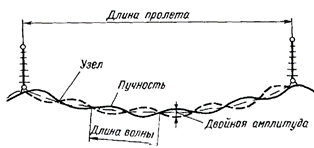
Rice. 2. Vibration waves along the wire in flight
Based on observations and research, it was found that the risk of wire breakage depends on the so-called Average operating voltage (voltage at average annual temperature and absence of additional loads).
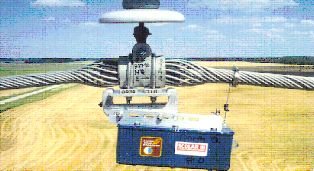
ALCOA "SCOLAR III" vibration recorder mounted on a spiral support
Methods of controlling the vibration of wires
According to PUE single aluminum and steel-aluminum wires with a cross section of up to 95 mm2 at distances of more than 80 m, cross section of 120 — 240 mm2 at distances of more than 100 m, cross section of 300 mm2 or more at distances of more than 120 m, steel wires and cables of all cross-sections at distances over 120 m must be protected from vibrations if the tension at the average annual temperature exceeds: 3.5 daN / mm2 (kgf / mm2) in aluminum conductors, 4.0 daN / mm2 in steel-aluminum conductors, 18.0 daN / mm2 in steel wires and cables.
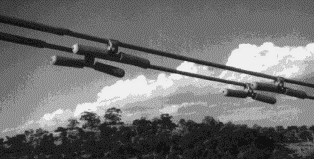
At distances smaller than the above, no vibration protection is required.Vibration protection is also not required on two-conductor split-phase lines if the stress at the average annual temperature does not exceed 4.0 daN / mm2 in aluminum and 4.5 daN / mm2 in steel-aluminum conductors.
Three- and four-wire phase separation usually does not require vibration protection. Sections of all lines that are protected from crosswinds are not subject to vibration protection. At large crossings of rivers and water areas, protection is required regardless of the voltage in the wires.
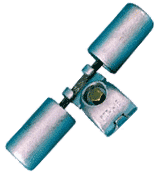 As a rule, it is economically unprofitable to reduce the voltages in line conductors to values where no vibration protection is required. Therefore, on lines with a voltage of 35 — 330 kV, vibration dampers made in the form of two weights suspended on a steel cable.
As a rule, it is economically unprofitable to reduce the voltages in line conductors to values where no vibration protection is required. Therefore, on lines with a voltage of 35 — 330 kV, vibration dampers made in the form of two weights suspended on a steel cable.
Vibration dampers absorb the energy of the vibrating wires and reduce the amplitude of the vibrations around the clamps. Vibration dampers must be installed at certain distances from the terminals, determined depending on the brand and voltage of the wire.
On a number of vibration protection lines, rebars made of the same material as the wire are used and wound around the wire at the point where it is fixed in the bracket for a length of 1.5 — 3.0 m.
The diameter of the bars decreases on either side of the center of the bracket. Reinforcing bars increase the stiffness of the wire and reduce the likelihood of vibration damage. However, vibration dampers are the most effective means of dealing with vibrations.
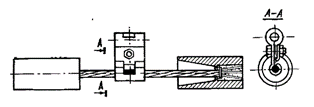 Rice. 3. Vibration damper on the wire
Rice. 3. Vibration damper on the wire
For vibration protection of single steel-aluminum wires with a cross-section of 25-70 mm2 and aluminum with a cross-section of up to 95 mm2, loop-type dampers (damper loops) suspended under the wire (under the supporting bracket) in the form of a loop with a length of 1.0 are recommended -1.35 m of wire of the same section.
In foreign practice, loop dampers of one or several consecutive loops are also used to protect wires with a large cross-section, including wires at large transitions.

Dance on the wires
The dance of wires, like vibrations, is excited by the wind, but differs from vibrations with a large amplitude, reaching 12-14 m and a long wavelength. On lines with single wires, a dance with one wave is most often observed, that is, with two half-waves in the range (Fig. 4), on lines with split wires - with one half-wave in a span.
In a plane perpendicular to the axis of the line, the wire moves when it dances along an elongated ellipse, the main axis of which is vertical or deviated at a slight angle (up to 10 — 20 °) from the vertical.
The diameters of the ellipse depend on the sag arrow: when dancing with one half wave in the range, the large diameter of the ellipse can reach 60 - 90% of the sag arrow, while dancing with two half waves - 30 - 45 % of the sag arrow. The minor diameter of the ellipse is usually 10 to 50% of the length of the major diameter.
As a rule, wire dancing is observed in icy conditions. Ice is deposited on the wires mainly on the leeward side, as a result of which the wire gets an irregular shape.
When the wind acts on a wire with one-sided ice, the speed of the air flow at the top increases and the pressure decreases.This results in a lifting force Vy causing the wire to dance.
The danger of dancing lies in the fact that the vibrations of the wires of individual phases, as well as of wires and cables, occur asynchronously; there are often cases where wires run in opposite directions and come close or even collide.
In this case, electrical discharges occur, causing individual wires to melt, and sometimes wires to break. There were also cases when the conductors of the 500 kV lines rose to the level of the cables and collided with them.

Rice. 4: a — dancing waves on a wire in flight, b — a wire covered with ice in an air stream between them.
Satisfactory results from the operation of experimental lines with dance dampers is still not enough to reduce the distance between the wires.
On some foreign lines with insufficient distances between conductors of different phases, insulating distance elements are installed, which exclude the possibility of the conductors catching during dancing.

